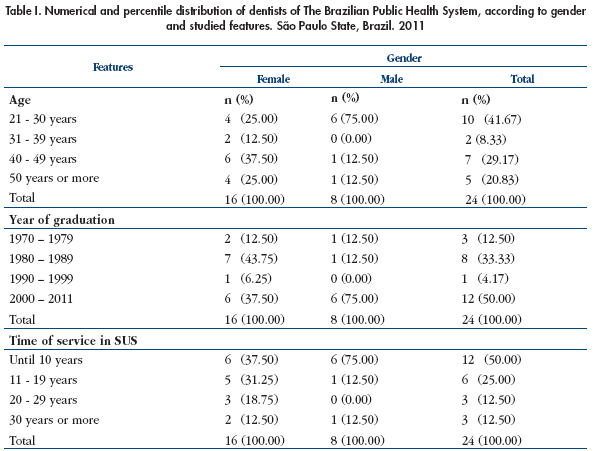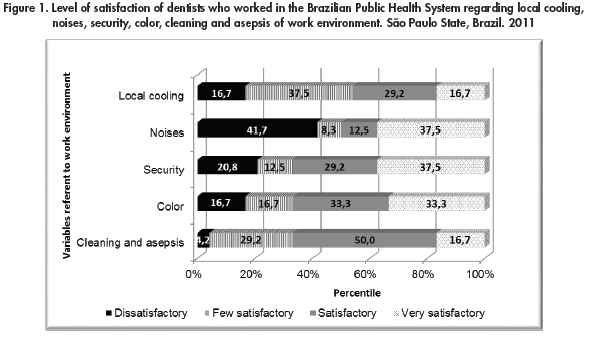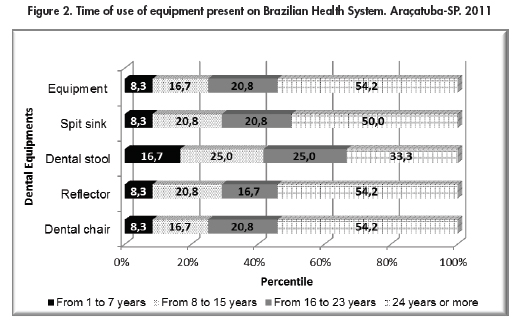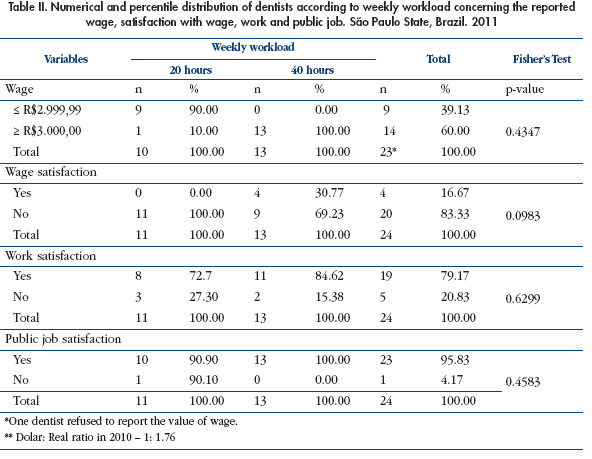My SciELO
Services on Demand
Journal
Article
Indicators
-
 Cited by SciELO
Cited by SciELO -
 Access statistics
Access statistics
Related links
-
 Cited by Google
Cited by Google -
 Similars in
SciELO
Similars in
SciELO -
 Similars in Google
Similars in Google
Share
Medicina y Seguridad del Trabajo
On-line version ISSN 1989-7790Print version ISSN 0465-546X
Med. segur. trab. vol.60 n.234 Madrid Jan./Mar. 2014
https://dx.doi.org/10.4321/S0465-546X2014000100005
ORIGINAL
Work conditions and occupational health of dentists in Brazilian Public Health System
Condiciones de trabajo y salud ocupacional del cirujano-dentista en el Sistema Brasileño Público de Salud
Suzely Adas Saliba Moimaz1, Tânia Adas Saliba Rovida2, Milene Moreira Silva3, Mirelli Ramiro da Silva4, Cléa Adas Saliba Garbin5
1. Full Professor - Univ Estadual Paulista Unesp / UNESP- School of Dentistry - Araçatuba Campus.
2. Assistant Professor - Univ Estadual Paulista Unesp / UNESP - School of Dentistry - Araçatuba Campus.
3. Doctorate student - Preventive and Social Dentistry Post-graduation Program / UNESP.
4. Master degree candidate - Preventive and Social Dentistry Post-graduation Program / UNESP.
5. Adjunct Professor - Coordinator of Preventive and Social Dentistry Post-graduation Program / UNESP.
Financial Support: CNPq (Brazilian Council in Science and Technology) - for financier support and CAPES (Coordination for the Improvement of Higher Education Personnel) for the Scholarships of Master and Doctorate.
ABSTRACT
Introduction: work healthy conditions are essential for a great professional performance.
Objective: To verify the perception of dentists regarding structural and healthy conditions of dental offices in the Brazilian Public Health System (SUS) and their satisfaction with work and public job.
Material and Method: In this cross-sectional study, type inquiry, 24 Brazilian dentists were interviewed. The follow variables were asked: cleaning and asepsis; maintenance and time of use of dental equipment; satisfaction with work and public job.
Results: The professionals were "satisfied" or "very satisfied" with cleaning and asepsis (66.67%); Dental equipment (54.17%), reflectors (54.17%) and the dental chairs (54.17%) had more than 24 years of use; 20% of all professionals said that the equipment had maintenance but only to fix them. Of total, 58.33% had already given no attendance for patients and broken equipment was the most frequent cause (92.86%). It was observed satisfaction with work (79.1%) and public job (95.83%). It was concluded that dentists who worked in SUS were satisfied with public job, although they had said the need for improvement on structural and healthy work conditions.
Keywords: Job satisfaction, working conditions, occupational risks, labor force, working environment.
RESUMEN
Introducción: Condiciones de trabajo saludables son esenciales para un buen desempeño professional.
Objetivos: verificar la percepción del cirujano-dentista en relación al ambiente de trabajo, con respecto a las condiciones físicas y sanitárias de los consultórios odontológicos del sistema público de salud brasileño, la satisfacción con la profesión y el empleo público.
Materiales y métodos: en este estudio transversal, tipo cuestionario, 24 cirujanos-dentistas brasileños fueron entrevistados. Se evaluaron las variables: limpeza y asepsia del consultorio odontológico; mantenimiento y tiempo de uso de los equipamientos; satisfacción con el trabajo y el empleo público.
Resultados: Los profesionales estaban "satisfechos" o "muy satisfechos" con la limpieza y asepsia (66,67%); equipos (54,17%), reflectores (54,17%) y los sillones dentales (54,17%) estaban en uso hace más de 24 años; 20% del total dijeron que había mantenimiento de esos equipamientos, apenas para reparos de daños. Del total, 58,33% dejaron de atender paciente, y equipo malogrado fue el motivo más frecuente (92,86%). Se observó satisfacción con la profesión (79,17%) y con el empleo público (95,83%). Se concluyó que los cirujanos-dentistas del SUS estaban satisfechos con el trabajo en el servicio público, a pesar que relataron la necesidad de mejorar las condiciones físicas y sanitarias en los ambientes de trabajo.
Palabras clave: Satisfacción en el empleo, Condiciones de Trabajo, Riesgos ocupacionales, Fuerza de Trabajo, Ambiente de trabajo.
Introduction
The Worker's Health is a multidisciplinary area of Public Health and Community Health and its purpose is the health-disease process of human in relation to work, focusing on prevention of occupational diseases and the decreasing of risks of accidents(1).
According to competent authority and regarding Security and Occupational Medicine, the employers must guarantee the prevention and health promotion at work environments, providing to workers the adequate conditions to make possible the execution of their functions, to reduce the risk for common accidents and those unexpected and/or occupational diseases(1). When the protocols of prevention of occupational accidents, occupational diseases and some injuries are not guaranteed by public policies or regulations, its notable the damage of worker's health(2).
In Brazil, the National Policy of Health and Security of Worker, which its aim is to promote frequently the improvement of quality of life and the health to workers through the communication and the links with the Government actions focusing on production/consumption and environment/health ratios, gives legal base to incorporate the prevention aspects of risks and accidents in the Brazilian Public Health Services; the environmental changing and prevention of occupational diseases with a common aspect, aiming social and politic determinants referent to the basic condition of life, work and job(1).
Concerning work conditions, it's important to highlight that inadequate work environment, materials and inappropriate environment organization are factors that can interfere on people's health, and consequently, on professional's performance, on quality of given services, on worker's satisfaction and on community's health(3).
Among the human resources in health, the dentistry professionals deserves more attention due to their frequent, permanent and worrisome exposition at occupational risks and due also to its interference on workers' health and quality of life, mainly the dentist. Didactically, these risks are considered as daily and continuous, physical, chemical, biological, ergonomic, mechanical and/or some related to accidents(4).
Focusing on efficiency and efficacy of the public dental services, the compromise with environment and the improving of work conditions for maintenance of workers' health, there is a need for researches in services, evaluating the involved individuals, mainly the health workers(5).
The guarantee of ideal structural conditions and the opinion of workers regarding work conditions are objects of research in Brazil, because there is a need for maintenance of workers' health to get good quality on the services offered to population(5,6).
Thus, it was aimed to verify the perception of dentists regarding structural and healthy conditions of dental offices in the Brazilian Public Health System, their satisfaction with their work and public job.
Material and methods
The Ethic Committee in Research with Humans of Univ. Estadual Paulista - School of Dentistry - UNESP approved the present study and all dictates of Resolution 196 of Brazilian Council in Health were severely respected.
Deal with a cross-sectional study, type inquire, where the dentists who worked on the Brazilian Public Health System (SUS) of a city of São Paulo State (N=34) during 2011, were invited to make part of research.
Previously, it was performed a pilot study with dentists from a similar city of this research to verify the consistence of answers.
Only the professionals who had assigned the Statement of Consent and the Authorization of data exposition were included on sample. Those who were not present at the moment of interviews, were not present on their work places and even after two posterior attempts they were not located, those who did not assign the Consent Term or refused to answer the questionnaire, these professionals were excluded of sample.
It was used for interview an instrument with opened and closed questions about dentists' view regarding structural and healthy conditions of work environment, their satisfaction with profession and with public job on health system. The interviews were carried out at work environment, individually, by only one trained researcher. It was respected the time enough for each dentist express their perceptions without constraint, coercion or interference.
The follow variables related to the profile of dentists who worked on Brazilian Public Health (SUS) System were studied: gender, age, year of graduation, post-graduation, time of experience on the SUS. Concerning professional's satisfaction with work environment it was verified their opinion about local cooling, noises, security, color, cleaning and asepsis of dental offices. The infra-structure of SUS for dental services was measured by dentists' reports in regard to available equipment, and its maintenance and time of use. On the topic of helped work, it was verified whether the dentists worked with help of auxiliary or alone. The labor profile of interviewed dentists was designed based on workload weekly, reported wage, their wage satisfaction, satisfaction with work and public job.
Data were analyzed using the software EpiInfotm (version 3.5.3)(7) and the BioEstat® (version 5.3)(8). It was applied Fisher's Test with 5% of significance level for bivariate analysis.
Results
Among the 34 dentists who worked on public health system, 9 (26.5%) were on leave in service due to health problems or pregnancy and 1 (2.9%) was on vacation, and thus, 24 (70.6%) composed the final sample.
The features of professionals' profile are showed on Table I, according to gender, while on Figure 1 it's observed the results about dentists' satisfaction in regard to work environment.
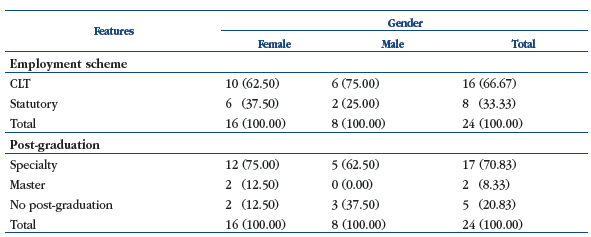
The Figure 2 shows the time of use of equipment available on the public dental offices. It's important to highlight that 20% of all said there was maintenance of the equipment, but all of them confirmed that the maintenance was performed only when the equipment showed some malfunctions.
Among all the interviewed workers, 58.3% had already interrupted the attendance for population due to broken equipment (92.9%), lack of consumption materials (14.3%), lack of electric energy (14.3%) or public water supply (7.1%). This question allowed the dentists to opt for one or more causes.
Concerning equipment available on dental services, 95.8% of work places showed photopolymerizer, 41.7% showed X-ray machine, 45.8% autoclave, 58.3% oven, 16.7% prophylaxis, 8.3% vacuum pump, 75.0% amalgamator, 95.8% dental high-speed equipment, 75.0% dental low-speed equipment, 87.5% dental low-speed equipment with contra-angle and 25.0% dental low-speed equipment with straight piece.
Only 58.3% of professional worked at 4 hands, it means that a great part of dentists worked without the help of dental auxiliary.
On Table II, data related to reported wage, wage satisfaction, satisfaction with work and with the public job are divided according to the weekly workload. It was observed that only one worker said that he/she was "few satisfied" with public job. The satisfaction with public job had no association with any of variables on table (p>0.05).
Discussion
In this cross-sectional study it was evaluated the dentists' satisfaction with structural and healthy work conditions in the Brazilian Public Health System, their satisfaction with work and with public job. It was verified wage dissatisfaction, although satisfaction with public job.
With respect to the ideal structural work environment, is notorious report that the walls painted with primary colors can stimulate considerably more the perception of dentists regarding the details and their view in relation to work area (mouth) than walls colored with other tonalities, especially when it are combined with different intensities of lightning(9,10). In dentistry, which work area is very small and limited and the details should be observed closely because they reflect directly on the final result, is essential that the dentist have a comfortable work environment. This point can highlight the needs for harmony between lightning (reflector and roof) and color of walls aiming to stimulate the visual skill of dentists. In the present study, dentists did not demonstrate dissatisfaction in regard to color of walls.
One of the occupational problems resultant of Dentistry exercise is the hearing. There is a notable dissatisfaction in regard to the noises present in the work environment, because it can damage the exercise of the professionals' daily activities due to the resultant stress. Besides, the longer the time of exposure at noises and the more near of limit of acoustic comfort are the noises, the higher the possibility the dentists suffer damage or loss of their hearing ability. Consequently, there is a need for preventive attitudes as the use of protector earphone, to avoid hearing lesions over the professional life(11).
Concerning frequent maintenance of dental equipment, it's implicit that it is essential to structure of any system of dental attendance, and it should be one of the central focuses of attention on the management of dental public services, considering that the most frequent cause of no attendance for patient, generally is broken equipment.
Not only broken equipment, but also the instruments and/or infra-structure can compromise the attendance for population. The lack of oven or autoclave, indispensable equipment for sterilization of instruments, can damage correct practices of biosecurity on the health services. It's important the monitoring and the frequent maintenance of these equipment to guarantee effectiveness on sterilization of instruments(12).
Observing the old equipment (long time of use) and the absence of preventive maintenance, these aspects can justify the negative contribution for the health of dentists and dental auxiliary, because it do not allow correct nor comfortable position to work. The renewing of equipment is essential to allow the ergonomic on professional practice of dental team and prevent future occupational diseases(13).
The dentists make part of professional class that is frequent musculoskeletal disorders(14). The changes on upper limbs and spine are common among dentists manifesting through signals and symptoms which can interfere on functional ability of them(15).
Spine pain is the most frequent type of pain among dentists and it result mainly to be sat over a long time, to force some posture during the performance of dental proceedings and to realize repetitive movements(16). Great part of professionals still worked alone, without the help of dental auxiliary, and consequently, without the possibility to apply work techniques at four hands, increasing the risks of occurrence of musculoskeletal lesions.
Thus, it's necessary that workers analyze carefully the policies that guarantee occupational health, especially regarding ergonomic aspects(17), this means that ergonomic dental equipment and/or presence of dental auxiliaries.
Other studied variables can be considered as factors which can interfere direct or indirectly on job satisfaction, prevention of occupational diseases, and consequently, on quality of offered services.
When dentists work into environments with comfortable, equipped and structural ideal conditions, their performance is better and the offered services becomes high quality, because professionals can practice their job with satisfaction and preserving the own health status(13).
The work satisfaction is essential because affect directly the quality of life of the health professionals, mainly in regard to their mental health(18), due to the work environments have been shown the strong expression of globalization and professional instability, and these aspects can display them to frustrations and emotional repertoire, resulting on labor stress and make them to bearing the burdens(19), that means, Burnout Syndrome. Recently it can be considered that 50% of dentists have been affected by this syndrome, mainly those younger than 40 years old and less than 10 years of service(20, 21).
Although the response rate has been acceptably good, one of the principal limitations of this type of research was that the answers of individuals maybe not correspond to their reality, because perhaps there is the afraid of political pursuit and it's important to consider that make part of research is not routine of Brazilians.
Moreover, work satisfaction is not directly related to wage satisfaction because the wage is not a motivating factor when it is considered in isolation, but is a general attitude of the professional front to own work and is vulnerable to various psychosocial factors. It is understood so that the remuneration is a key driver of work dissatisfaction, however it is not the main determinant of work satisfaction(22).
In this study, it was observed predominant satisfaction with public job, probably due to labor benefits as 13th wage and vacation, financial stability and to make strong the employment link, although the absence of Plan of Places, Carrier and Wage.
Although all of participants were previously cleared and informed concerning description of data and secrecy of identity, this research can show bias of information due to political aspects, because the majority of professionals were dissatisfied with their wage and their environmental work, not considering it as comfortable mainly about local cooling, because the local climate use to be hot and thus, there is needs for fan and air conditioner at the work environment for offering the health services.
It suggested that more researches can be performed to show to the health managers the real work condition of public workers and consequently, the health services offered to population.
It was concluded that the dentists of SUS were satisfied with the public job, although they had shown structural and healthy conditions needed for improving at the work environment where they offer health attendance for population.
Reference
1. Ministério da Saúde (Brasil). Portaria n.o 1.125, de 6 de julho de 2005. Dispõe sobre os propósitos da política nacional de saúde do trabalhador para o SUS. Diario Oficial da República Federativa do Brasil 2005 jul. 7. [ Links ]
2. Verbeek J, Ivanov I. Essentil occupational safety and health interventions for low-and middle-income countries: an overview of the evidence. Saf Health Work, 2013; 4(2): 77-83. [ Links ]
3. Agência Nacional de Vigilância Sanitária (Brasil). Resolução RDC n.o 0, de 21 de fevereiro de 2002. Dispõe sobre o Regulamento Técnico para planejamento, programação, elaboração e avaliação de projetos físicos de estabelecimentos assistenciais de saúde. Diario Oficial da República Federativa do Brasil 2002 mar. 20. [ Links ]
4. Wijk PT, Meiberg AE, Bruers JJ, Groenewold MH, van Raalten AL, Dam BA, Schneeberger PM. The risk of blood exposure incidents in dental practices in the Netherlands. Community Dent Oral Epidemiol, 2012; 40(6): 567-73. [ Links ]
5. Ministério da Saúde (Brasil). Agenda nacional de prioridades de pesquisa em saúde. Brasília: Ministério da Saúde; 2008. [ Links ]
6. Levin RP. Reclaiming the Passion for Dentistry. J Am Dent Assoc, 2008; 139(6): 765-6. [ Links ]
7. Centers for Disease Control and Prevention. Epi Info™, a database and statistics program for public health professionals. Atlanta: Centers for Disease Control and Prevention; 2007. [ Links ]
8. Ayres M, Ayres Jr M, Ayres DL, Santos AAS. BioEstat: aplicações estatísticas nas áreas das ciências biomédicas. Belém: MCT/CNPq; 2007. [ Links ]
9. Lin CC, Huang KC. Effects of color combination and ambient illumination on visual perception time with TFT-LCD. Percept Mot Skills, 2009; 109(2): 607-25. [ Links ]
10. Dianat I, Sedghi A, Bagherzade J, Jafarabadi MA, Stedmon AW. Objective and subjective assessments of lighting in a hospital setting: implications for health, safety and performance. Ergonomics, 2013. In press. [ Links ]
11. Garbin AJI, Garbin CAS, Ferreira NF, Luiz N. Evaluación de la incomodidad ocupacional: nivél del ruido de una clinica de graduacion. Acta Odontol Venez, 2006: 44(1):42-6. [ Links ]
12. Matsuda JK, Grinbaum RS, Davidowicz H. The assessment of infection control in dental practices in the municipality of São Paulo. Braz J Infect Dis, 2011; 15(1):45-51. [ Links ]
13. Rolander B, Jonker D, Winkel J, Sandsjö L, Balogh I, Svensson E, Ekberg Kl. Working conditions, health and productivity among dentists in Swedish public dental care: a prospective study during a 5-year period of rationalisation. Ergonomics, 2013; 56(9):1376-86. [ Links ]
14. Orenha ES, Eleutério D, Saliba NA. Organization of odontology attempt in public health: dental assistant, productivity and clinic rooms. Rev Odontol Unesp, 1998; 27(1): 215-24. [ Links ]
15. Thornton LJ, Barr AE, Stuart-Buttle C, Gaughan JP, Wilson ER, Jackson AD, Wyszynski TC, Smarkola C. Perceived musculoskeletal symptoms among students in the clinic work environment. Ergonomics 2008; 51(4): 573-86. [ Links ]
16. Al-Ali K, Hashim R. Occupational health problems of dentists in the United Arab Emirates. Int Dent J, 2012; 62(1): 52-6. [ Links ]
17. Poblete CM, López JV, Pareto NM. Factores de riesgo ergonómico y su relación con dolor musculoesquelético de columna vertebral: basado en la primera encuesta nacional de condiciones de empleo, equidad, trabajo, salud y calidad de vida de los trabajadores y trabajadoras en Chile (ENETS) 2009-2010. Med Segur Trab, 2012; 58(228): 194-204. [ Links ]
18. Díez PB, Albi TR, Burón DQ, Santiago FR, León MMM, Merino PA, Díez CB. Calidad de vida relacionada con la salud en trabajadores sanitarios. Med Segur Trab, 2012; 58(226): 27-34. [ Links ]
19. Carvajal RR, Hermosilla SR. Los procesos de estrés laboral y desgaste profesional (burnout): diferenciación, actualización y líneas de intervención. Med Segur Trab, 2011; 57(Sup. 1): 72-88. [ Links ]
20. Sur H, Hayran O, Mumcu G, Soylemez D, Atli H, Yildirim C. Factors affecting dental job satisfaction: a cross-sectional survey in Turkey. Eval Health Prof, 2004; 27(2): 152-64. [ Links ]
21. Aguilera EC, García JEGA. Prevalencia del síndrome de desgaste profesional (burnout) en odontólogos mexicanos del sector educativo y privado. Med Segur Trab, 2012; 58(228): 246-60. [ Links ]
22. Siqueira VTA, Kurcgant P. Job satisfaction: a quality indicator in nursing human resource management. Rev Esc Enferm USP, 2012; 46(1): 151-7. [ Links ]
![]() Correspondence:
Correspondence:
Milene Moreira Silva
E-mail: mileninhamoreira@yahoo.com.br
Faculdade de Odontologia de Araçatuba - FOA/Unesp
Programa de Pós-graduação em Odontologia Preventiva e Social
Rua José Bonifácio, 1193, Vila Mendonça
CEP 16015-050 Araçatuba - SP, Brasil
Fone: +55 (18) 3636-3249 / +55 (18) 3636-3250
Fax: +55 (18) 3636-3332
Recibido: 11-11-13
Aceptado: 20-01-14













